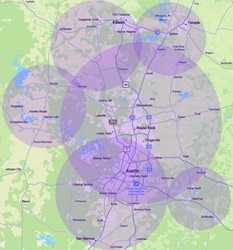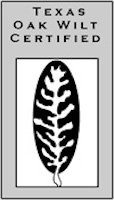What is Oak Wilt?
Oak wilt is caused by a fungus called Bretziella fagacearum. It is a deadly tree disease, killing millions of central Texas oak trees every year.
Trees get water and nutrients from their roots. They transmit nutrients through “veins” in the trunk, up to the branches and leaves. Oak wilt clogs the veins of the tree, so it can’t deliver food and water to the rest of the tree. Infected trees start to die from the top down, because it’s hardest to get the liquid to the top of the tree.
Can My Trees Get Oak Wilt?
All common central Texas oak trees are susceptible to oak wilt disease.
These central Texas trees are not oak trees, so they are not susceptible to oak wilt disease: cedar, elm, maple, olive, sycamore, magnolia, pear, walnut, elder, and hackberry.
Is Oak Wilt Dangerous?
Yes. An infestation could kill your oak tree. How long your infected tree will live depends on the species:
- Red oak trees are very susceptible to oak wilt disease. Once infested, they generally die within 4 to 6 weeks.
- Live oaks are more resistant than red oaks. A small percentage survive infection, but most infected live oak trees die within 2 years.
- White oak trees are the most resistant to the disease. Depending on the species, many of them can survive, though they suffer canopy loss.
How Does Oak Wilt Spread?
Oak wilt can spread underground, through connected oak trees’ roots. It can also spread above ground. Sap beetles eat oak tree sap. When they eat the sap of an infected tree, the fungus spores stick to them, and they carry the spores to other oak trees.
Sap is exposed when trees are wounded – through pruning or damage from landscaping, construction or storms. It is very important to promptly paint/seal all oak tree wounds – especially during the spring and early summer – so that sap from the wounds will not attract sap beetles.
Arborists Help Control Oak Wilt
Oak Wilt can also spread through contaminated tree pruning tools. Our professional arborists take great care to prevent the spread of oak wilt disease.
- We sterilize all of our equipment after each individual tree. (It is not necessary to sterilize after every pruning cut, just in between trees.)
- We promptly seal all pruning cuts.
During Oak Wilt season, our arborists do not make pruning cuts to oak trees unless it is absolutely necessary. Storm damage causes rough and jagged broken branches. These wounds must be properly trimmed and sealed to protect the tree. We do not spread oak wilt.
What Does Oak Wilt Look Like?
Red Oak Trees
Common red oak trees in central Texas include: spanish oak, shumard oak, and blackjack oak. Red oak trees are the most susceptible to oak wilt disease. Infected red oak trees typically die within 4 weeks.
If a red oak tree starts changing colors at the wrong time, it may be infected with oak wilt disease.
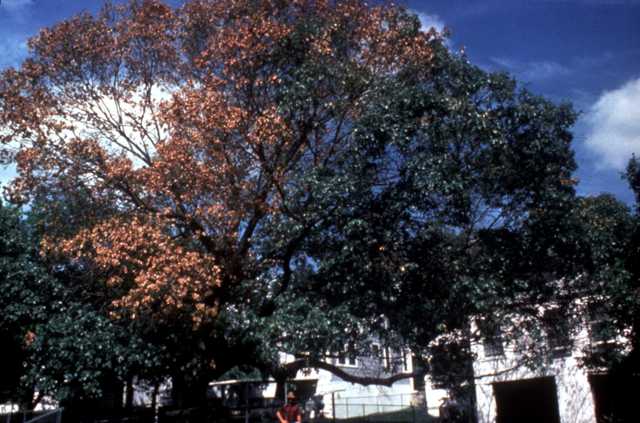
Photo credit: texasoakwilt.org
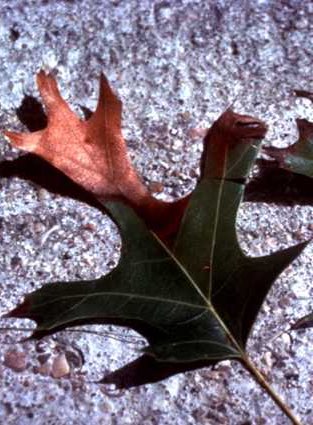
Photo credit: texasoakwilt.org
White Oak Trees
White oak trees are more resistant to oak wilt, depending on the species. Oak trees in the white oak family include: post oak, bur oak, chinquapin oak, and lacey oak trees.
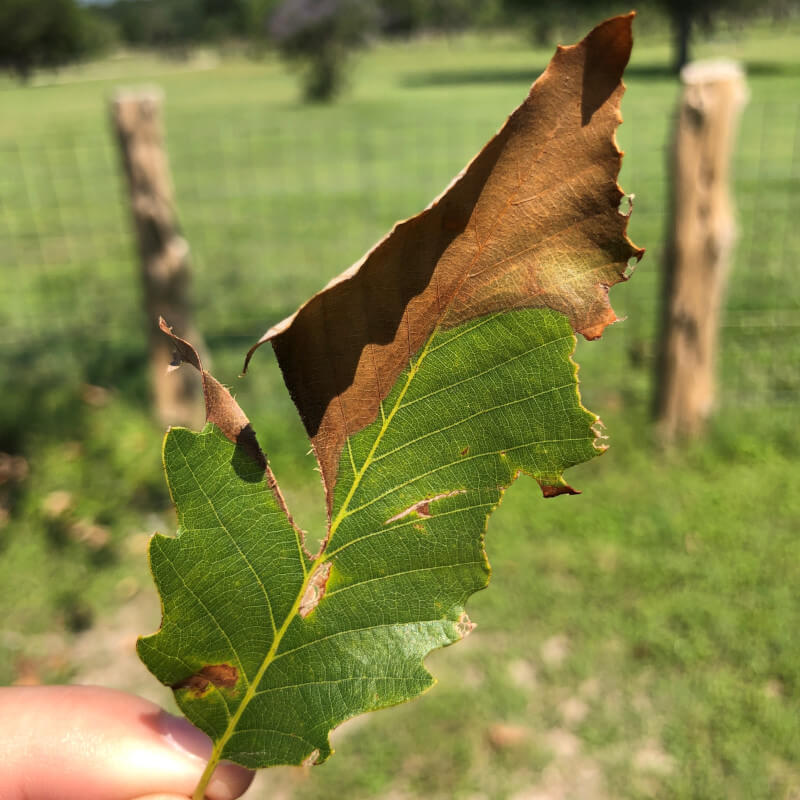
Live Oak Trees
Live oak trees with oak wilt have a specific leaf discoloration. Their veins turn yellow, then orange, finally brown. An infected live oak tree will generally have many leaves on the ground with brown veins.
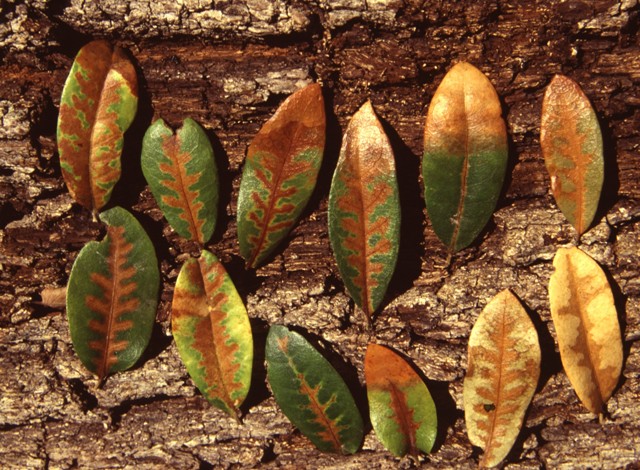
Worried About Oak Wilt?
If you are concerned about oak trees on your central Texas property, call or message Good Morning Tree Service to talk to a professional arborist.
Free On-Site Estimates
7am – 7pm
7 days a week
Can We Prevent Oak Wilt?
There are several things property owners can do to help prevent oak wilt.
1) DON’T Prune at the Wrong Time
Do NOT prune Texas oak trees from February 1 – June 30.
The beetles that carry oak wilt spores are most active from February through June. They eat the oak tree sap, which can only be accessed through a wound – a broken branch or damaged trunk. Many central Texas communities have ordinances restricting routine oak tree pruning from February 1 through June or mid-July.
Texas A&M University maintains a page of community oak wilt restrictions and ordinances: texasoakwilt.org/community-tools/city-ordinances
These restrictions generally apply to property owners – professional arborists can service your oak trees during restricted periods, especially in emergency situations.
2) DO Prune at the Right Time
DO prune Texas oak trees during the cold winter months.
We prune oak trees to remove weak branches that could fall during a storm, opening a fresh wound. Branches that are rubbing together can also wound the oak tree, and expose it to Oak Wilt. Professional arborists can properly remove weak or problematic limbs, seal the wounds, and make your tree as strong as possible, going in to oak wilt season.
3) DO Prune Correctly
It is important to make pruning cuts outside the limb’s bark collar. Trees can’t seal over cuts too close to the trunk. Pruning cuts that damage the bark collar cause decay, creating a hole in your tree. This is an even bigger opportunity for oak wilt or other infestations to enter your tree.
4) Sterilize and Seal
Sometimes you have to prune an oak tree during Oak Wilt season – to clean up storm damage, for example. If your oak tree needs this kind of help, it is very important to protect your oak tree, and the other oak trees in your neighborhood.
- Make sure the cutting tools are sterile – pruning equipment should be sterilized after each individual tree.
- Promptly seal all fresh oak tree wounds.
5) Fungicide Treaments Can Help
Individual oak trees can be protected with fungicide injections. The tree must not have symptoms of oak wilt disease, and should be at least 100 feet away from any other infected tree.
Fungicide injection costs vary by the size of the tree. Larger trees are more expensive because they require more medicine.
Stand next to your tree and wrap your arms around it. (Yes! Hug that tree!) If your hands can touch each other behind the tree, a fungicide treatment will cost around $325.
To remain effective, the fungicide treatment needs to be repeated every 3 years.
Need Oak Tree Help?
We can help your central Texas oak trees live their longest, healthiest life. Call or message us now to schedule an appointment with our professional arborists.
Free On-Site Estimates
7am – 7pm
7 days a week

